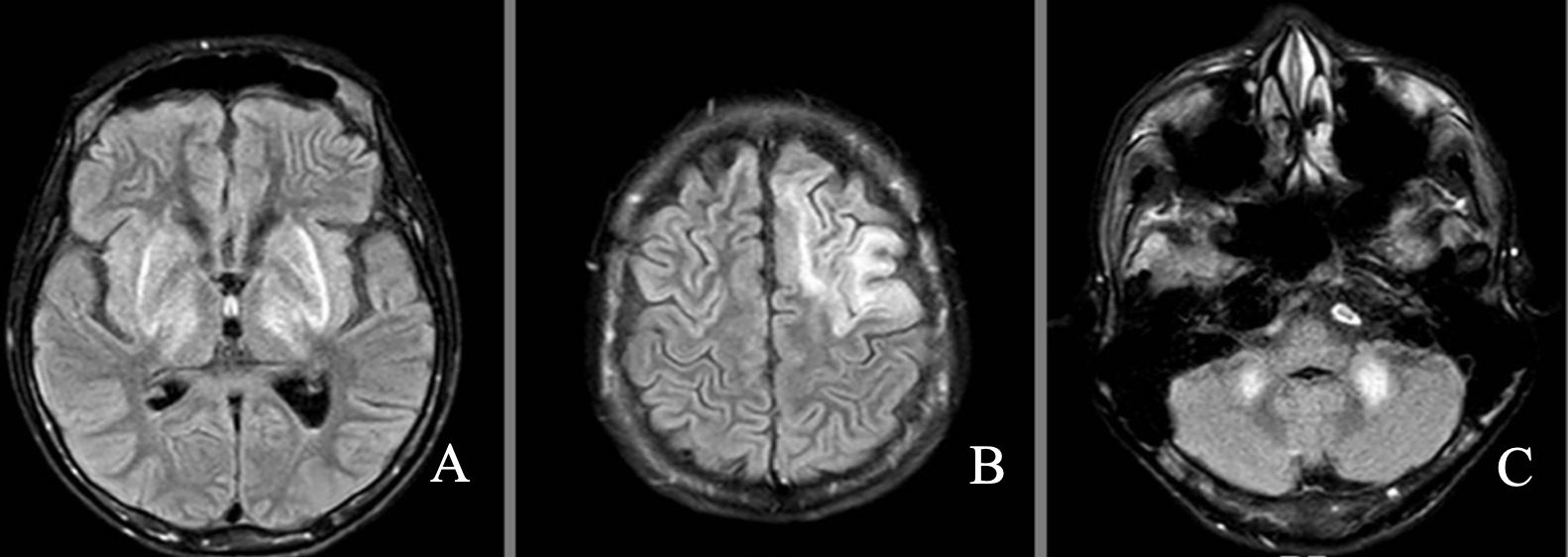Objective: To describe a Wilson disease (WD) case report with severe neurological manifestations who was successfully treated with zinc salt monotherapy, due to unavailability of oral chelators.
Background: WD is a rare autosomal recessive disorder resulting in systemic symptoms. Patients usually present hepatic (30–50%), neurological (30–40%), or psychiatric (30–40%) manifestations.
Method: A WD case report.
Results: A 19 years-old male presented with a 3-year history of progressive upper limb tremor, dysarthria, dysphagia and generalized dystonia. Past medical history, including perinatal and neurodevelopmental, was unremarkable, with no relevant family background. At admission time, he presented with generalized dystonia and marked weight loss. The patient was bedridden, fed through gastrostomy (G-tube), and severely dependent for all basic daily activities. Brain MRI showed T2/FLAIR hyperintense lesions in the left frontal cortex, basal ganglia and cerebellar peduncles (figure 1). Laboratory workup revealed low ceruloplasmin levels (<8mg/dL) and liver ultrasound showed diffuse increased echogenicity, with no clinical or laboratorial evidence of liver damage. WD was suspected and genetic testing was performed, revealing two pathogenic variants in the ATB7B gene (Ala911Val and Lys1238Serfs*20) in compound heterozygosity, further confirmed by parental segregation. Oral copper chelators were unavailable in his region (northeast Brazil). Alternatively, he started on 50mg of elemental zinc thrice daily (zinc sulfate) and botulinum toxin injections.. The patient progressed with significant clinical improvement. After four months, he was able to walk without assistance and the G-tube was removed as he was able to safely eat by mouth (figure 2).
Conclusion: Challenges in choosing zinc as an initial monotherapy treatment option for WD are mainly due to paucity of literature reporting its use in that scenario. Zinc salts are generally recommended as maintenance therapy or for pre-symptomatic patients. European centers experience indicates that zinc can also serve as a safe, well-tolerated, and effective initial therapy for neurological symptoms in WD. Since WD is a treatable disorder, which is relentless fatal if untreated, zinc figures as viable option in resource-limited regions. In sum, WD treatment recommendations and researches should consider different economic status and medications availability worldwide.
MRI with WD lesions
Patient status before and after zinc therapy
References: 1. Roberts EA, Schilsky ML. Current and Emerging Issues in Wilson’s Disease. Longo DL. N Engl J Med, 2023;389(10):922–38.
2. Avan A, Członkowska A, Gaskin S, Granzotto A, Sensi SL, Hoogenraad TU. The Role of Zinc in the Treatment of Wilson’s Disease. Int J Mol Sci; 2022,(16):9316.
To cite this abstract in AMA style:
M. Soares, M. Santiago, A. Simeão, H. Galvão, P. Fontana, F. Travassos, M. Ramalho, R. Mendonça. Challenges in Wilson disease management in a resource-limited country: a case report from a tertiary center [abstract]. Mov Disord. 2024; 39 (suppl 1). https://www.mdsabstracts.org/abstract/challenges-in-wilson-disease-management-in-a-resource-limited-country-a-case-report-from-a-tertiary-center/. Accessed April 4, 2025.« Back to 2024 International Congress
MDS Abstracts - https://www.mdsabstracts.org/abstract/challenges-in-wilson-disease-management-in-a-resource-limited-country-a-case-report-from-a-tertiary-center/


